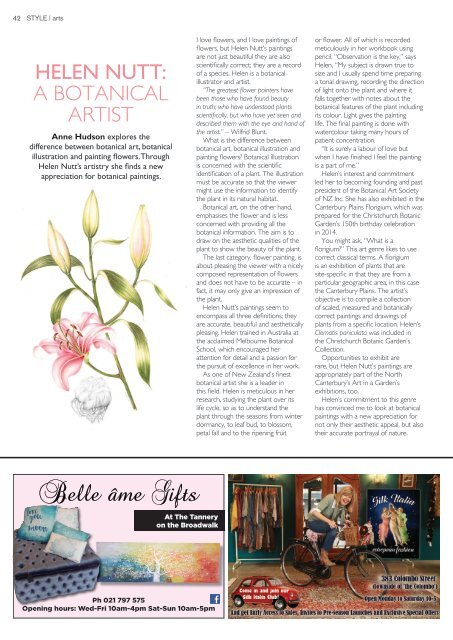Create successful ePaper yourself
Turn your PDF publications into a flip-book with our unique Google optimized e-Paper software.
42 Style | arts<br />
Helen nutt:<br />
A BotAnicAl<br />
Artist<br />
Anne Hudson explores the<br />
difference between botanical art, botanical<br />
illustration and painting flowers. Through<br />
Helen Nutt’s artistry she finds a new<br />
appreciation for botanical paintings.<br />
I love flowers, and I love paintings of<br />
flowers, but Helen Nutt’s paintings<br />
are not just beautiful they are also<br />
scientifically correct; they are a record<br />
of a species. Helen is a botanical<br />
illustrator and artist.<br />
“<strong>The</strong> greatest flower painters have<br />
been those who have found beauty<br />
in truth; who have understood plants<br />
scientifically, but who have yet seen and<br />
described them with the eye and hand of<br />
the artist.” – Wilfrid Blunt.<br />
What is the difference between<br />
botanical art, botanical illustration and<br />
painting flowers? Botanical illustration<br />
is concerned with the scientific<br />
identification of a plant. <strong>The</strong> illustration<br />
must be accurate so that the viewer<br />
might use the information to identify<br />
the plant in its natural habitat.<br />
Botanical art, on the other hand,<br />
emphasises the flower and is less<br />
concerned with providing all the<br />
botanical information. <strong>The</strong> aim is to<br />
draw on the aesthetic qualities of the<br />
plant to show the beauty of the plant.<br />
<strong>The</strong> last category, flower painting, is<br />
about pleasing the viewer with a nicely<br />
composed representation of flowers<br />
and does not have to be accurate – in<br />
fact, it may only give an impression of<br />
the plant.<br />
Helen Nutt’s paintings seem to<br />
encompass all three definitions; they<br />
are accurate, beautiful and aesthetically<br />
pleasing. Helen trained in Australia at<br />
the acclaimed Melbourne Botanical<br />
School, which encouraged her<br />
attention for detail and a passion for<br />
the pursuit of excellence in her work.<br />
As one of New Zealand’s finest<br />
botanical artist she is a leader in<br />
this field. Helen is meticulous in her<br />
research, studying the plant over its<br />
life cycle, so as to understand the<br />
plant through the seasons from winter<br />
dormancy, to leaf bud, to blossom,<br />
petal fall and to the ripening fruit<br />
or flower. All of which is recorded<br />
meticulously in her workbook using<br />
pencil. “Observation is the key,” says<br />
Helen, “My subject is drawn true to<br />
size and I usually spend time preparing<br />
a tonal drawing, recording the direction<br />
of light onto the plant and where it<br />
falls together with notes about the<br />
botanical features of the plant including<br />
its colour. Light gives the painting<br />
life. <strong>The</strong> final painting is done with<br />
watercolour taking many hours of<br />
patient concentration.<br />
“It is surely a labour of love but<br />
when I have finished I feel the painting<br />
is a part of me.”<br />
Helen’s interest and commitment<br />
led her to becoming founding and past<br />
president of the Botanical Art Society<br />
of NZ Inc. She has also exhibited in the<br />
Canterbury Plains Florigium, which was<br />
prepared for the Christchurch Botanic<br />
Garden’s 150th birthday celebration<br />
in 2014.<br />
You might ask, “What is a<br />
florigium?” This art genre likes to use<br />
correct classical terms. A florigium<br />
is an exhibition of plants that are<br />
site-specific in that they are from a<br />
particular geographic area, in this case<br />
the Canterbury Plains. <strong>The</strong> artist’s<br />
objective is to compile a collection<br />
of scaled, measured and botanically<br />
correct paintings and drawings of<br />
plants from a specific location. Helen’s<br />
Clematis paniculata was included in<br />
the Christchurch Botanic Garden’s<br />
Collection.<br />
Opportunities to exhibit are<br />
rare, but Helen Nutt’s paintings are<br />
appropriately part of the North<br />
Canterbury’s Art in a Garden’s<br />
exhibitions, too.<br />
Helen’s commitment to this genre<br />
has convinced me to look at botanical<br />
paintings with a new appreciation for<br />
not only their aesthetic appeal, but also<br />
their accurate portrayal of nature.<br />
At <strong>The</strong> Tannery<br />
on the Broadwalk<br />
Ph 021 797 575<br />
Opening hours: Wed-Fri 10am-4pm Sat-Sun 10am-5pm


















